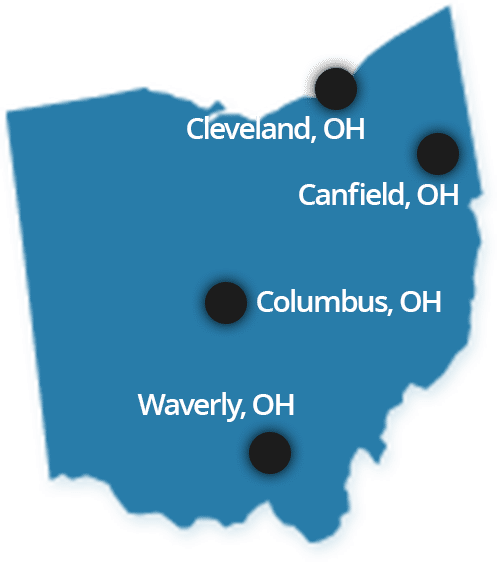In Ohio, manufacturing, transportation, and warehousing jobs make up nearly 20% of private-sector employment. As of November 2021, more than 925,000 Ohio workers were employed in these industries. So it’s no surprise that these industries also make up a significant share of Ohio work injuries.

In 2019, there were 91,000 non-fatal private-sector workplace injuries and illnesses reported in Ohio. The vast majority of these–more than 95%–were injuries. About half of these injuries and illnesses were relatively minor. 46,600 either resulted in lost work time or required a transfer or some sort of work restrictions. More than 40% of those days away from work, transfer, or restriction cases occurred in the manufacturing industry. The only sector responsible for a higher percentage of injuries serious enough to interfere with work was health care.
What Makes Manufacturing and Warehousing Dangerous?
One reason for higher injury numbers is the large number of jobs in these sectors. But that doesn’t tell the whole story. After all, manufacturing jobs make up about 14% of private-sector employment in Ohio and about 11% of workplace injuries, but account for 40% of injuries serious enough to require time away from work or other adjustments.
According to workers’ compensation carrier Travelers Insurance, most manufacturing industries fall into a few categories. In fact, just three incident types make up 83% of manufacturing accident claims:
- Contact with an object (40%);
- Overexertion (24%);
- Slips, trips, and falls (19%).
Two others make up an additional 14%, leaving just 3% in the “other” category:
- Repetitive motion (8%);
- Contact from harmful substances (6%).
In warehousing, the top causes are similar, with one exception: forklift incidents make up a significant portion of on-the-job injuries and deaths in the warehousing and materials moving industries.
Most Workplace Injuries are Preventable
While certain types of injuries are common in manufacturing and warehousing industries, that doesn’t mean those risks are inherent in the type of work performed. A wide variety of factors can make a warehouse or manufacturing plant safer or more dangerous. Some of these variables are within the worker’s control. Most or all of them are within the employer’s control. Some examples include:
- Safe layout of the facility;
- Clear, noticeable markings for forklift travel areas, changes in floor levels, dangerous areas, and more;
- Thorough training on safe methods for machine operation, safe lifting, and other aspects of the job;
- Good maintenance of machinery, forklifts, and other equipment;
- Issuance of well-maintained and appropriate safety gear;
- Clear processes and protocols so everyone on the floor knows what to expect.
Warehouse and Manufacturing Injury Rates Vary Significantly
Some employers do a better job of preserving workplace safety than others. 2021 reporting on injury rates in Amazon distribution facilities illustrates how significant the differences can be. The Cleveland Amazon facility is too new to have been included in the analysis of Amazon workplace injuries. But one Ohio warehouse landed in the spotlight. According to the Washington Post, the Obetz, Ohio facility had the third-highest cumulative injury rate among Amazon facilities nationwide from 2017-2020.
Of course, comparing one Amazon facility to another doesn’t reveal much about relative safety. For comparison, in 2019 the average rate of injury in warehouses nationwide was 5.2 per 100,000 full time employees. The serious injury rate was 4 per 100,000.
Some Amazon warehouses analyzed by the Center for Investigative Reporting had serious injury rates as high as 22.4 per 100,000 workers and overall injury rates as high as 25 per 100,000. Here’s how the Ohio facilities examined fared:
- North Randall, Ohio – 14.5 injuries per 100,000 workers and 12.8 serious injuries per 100,000 workers;
- Euclid, Ohio – 10.9 injuries per 100,000 workers and 9.8 serious injuries per 100,000 workers;
- Etna, Ohio – 7.9 injuries per 100,000 workers and 7.2 serious injuries per 100,000 workers;
- Obetz, Ohio – 12.5 injuries per 100,000 workers and 11.2 serious injuries per 100,000 workers;
- Monroe, Ohio – 11.8 injuries per 100,000 workers and 10.5 injuries per 100,000 workers.
Of course, this issue isn’t unique to Amazon–it’s simply useful for illustration because of the large amount of data available. Safety measures and safe workplace set-up differ significantly from one warehousing or manufacturing facility to another. Poor conditions or inadequate training can mean a two, three, or even five times higher rate of injury on the job.
Can I Sue My Employer if I’m Injured Due to Poor Safety Measures?
In Ohio, workers’ compensation is typically an exclusive remedy, meaning that you generally can’t sue your employer for negligence if you get hurt on the job. However, there are some special provisions that may allow you to pursue increased workers’ compensation benefits if your employer’s violation of safety standards caused your injury.
In some cases, you may also have a direct claim against a third party, such as the manufacturer of faulty equipment that contributed to your injury or failed to provide the promised protection.
The best way to determine what benefits or compensation may be available to you after a manufacturing or warehouse injury is to consult an experienced Ohio work injury attorney. At Plevin & Gallucci, we’ve been fighting for injured workers for decades. We have 50 years of experience helping clients who have suffered workplace injuries in warehouses. In recent years as Amazon has become more widely utilized by the public, we have represented and continue to represent a significant number of Amazon Warehouse employees for their work-related injuries. We offer free consultations to help you determine your next steps.
To schedule yours now, call 855-4PLEVIN or fill out the contact form on this page.

